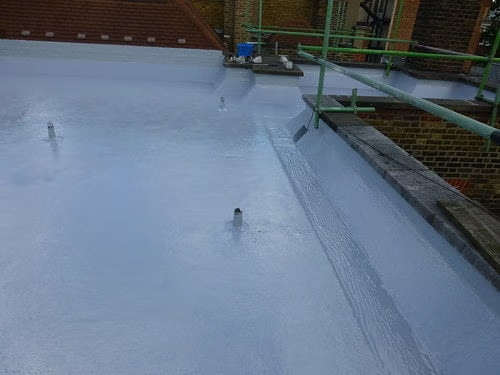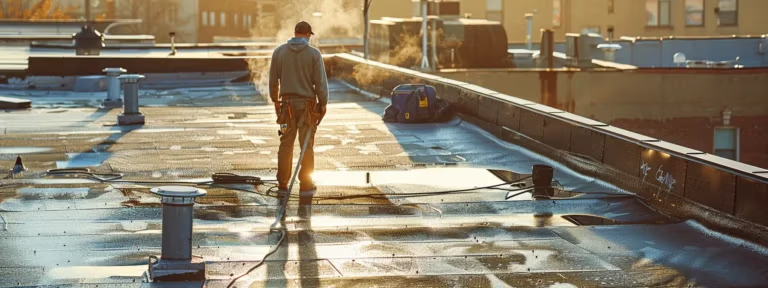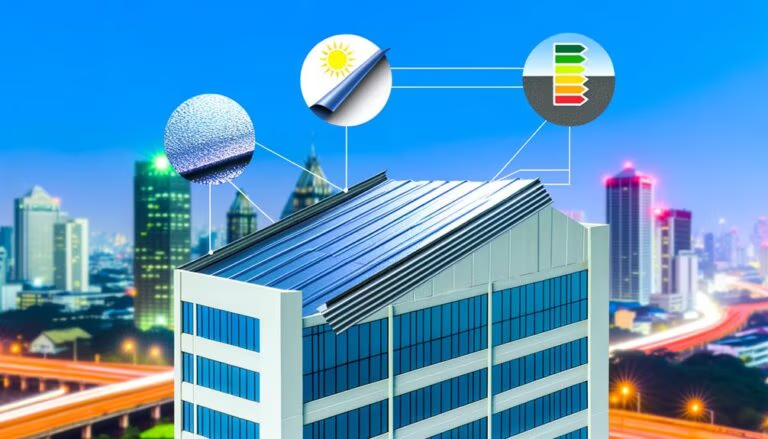Frequently Asked Questions
What are common signs of hail damage on flat roofs?
Common signs of hail damage on flat roofs include granule loss, dents or punctures in the roofing material, and exposed underlying membrane that can lead to leaks and structural degradation over time.
How do I know if my flat roof has hail damage?
Inspect the roof for signs of granule loss, small dents, or punctures. Look for discoloration or cracks in the roofing material. If unsure, consult a roofing professional to assess the extent of any hail damage.
How do I identify hail damage on a flat roof?
Inspect the roof for granule loss, dents, punctures, and damaged roofing materials. Look for signs of impact on the flat surface, as hailstones can create dents and compromise the integrity of the roof.
What is the process for filing a hail damage claim?
Inspect the roof for visible hail damage, such as dents, cracks, or missing granules.
Contact your insurance provider and report the hail event and damage.
Schedule an inspection with a roofing contractor to document the extent of the damage.
Submit a claim to your insurance provider, including the contractor's report and any photographic evidence.
Work with your insurance provider to determine the covered repairs and coverage amount.
Can hail damage lead to mold growth on a flat roof?
Yes, hail damage can lead to mold growth on a flat roof. Hail impacts can puncture or crack the roofing membrane, allowing water intrusion and creating an ideal environment for mold to thrive.
Can hail damage cause leaks on a flat roof?
Yes, hail damage can cause leaks on flat roofs. The flat surface of these roofs makes them vulnerable to hail impact, leading to granule loss, punctures, and other issues that can compromise the roof's waterproofing.
How to prevent hail damage on a flat roof?
Regularly inspect and maintain the roof, install hail-resistant roofing materials, ensure proper drainage to prevent pooling, and consider installing impact-resistant roof coverings or protective barriers. Prompt repairs of any hail-related damage are crucial.
Can hail damage on a flat roof be prevented with coatings?
Hail damage on a flat roof can be mitigated with protective coatings, such as elastomeric or silicone-based roof coatings. These coatings can help absorb the impact of hailstones and prevent punctures or other damage to the underlying roofing material.
What is the best way to inspect a roof for hail damage?
Inspect the roof visually for signs of hail impact, such as dented shingles, damaged flashing, or granule loss. If unsure, consult a professional roofer for a thorough inspection.
How long does it take to repair hail damage on a flat roof?
The time to repair hail damage on a flat roof can vary significantly depending on the extent of the damage. Minor damage may take a few days, while more extensive repairs could take several weeks.
How often should I inspect my roof for hail damage?
Roof inspections for hail damage should be conducted annually or after severe weather events. Regular professional inspections can identify issues early and ensure prompt repairs, preventing further damage.
How do I document hail damage on a flat roof for insurance?
To document hail damage on a flat roof for insurance:
Inspect the roof for visible signs of damage, including dents, punctures, or granule loss.
Take clear, detailed photographs of the damaged areas, noting the date and time.
Hire a professional roof inspector to provide a written assessment of the damage.
File an insurance claim with your policy provider, submitting the photographic evidence and inspection report.
Can hail damage on a flat roof be repaired?
Yes, hail damage to a flat roof can often be repaired. Potential repairs may include replacing damaged roofing materials, patching punctures, and restoring the protective granule layer. The extent and cost of repairs will depend on the severity of the hail impact.
Can hail damage cause structural damage to a flat roof?
Yes, hail can cause significant damage to flat roofs, including granule loss, dents, punctures, and even structural degradation over time. Flat surfaces are more vulnerable than sloped roofs, as hailstones cannot easily roll off.
Can you file an insurance claim for hail damage on a flat roof?
Yes, hail damage to flat roofs is typically covered by insurance policies, though coverage specifics may vary. Policyholders should document the damage and work with their insurer to file a claim.
How long after a hail storm should I inspect my roof?
It is recommended to inspect your roof for hail damage as soon as possible after a storm, ideally within 1-2 days. This allows for prompt identification and assessment of any issues before they worsen over time.
What are the most common types of hail damage on a roof?
The most common types of hail damage on a roof include:
Granule loss on asphalt shingles, exposing the underlying roofing material
Dents, cracks, and punctures in metal, tile, or slate roofing
Damage to roof flashing, vents, and other roof penetrations
How much does it cost to repair hail damage on a flat roof?
The cost to repair hail damage on a flat roof can vary depending on factors like the extent of the damage, roof size, and materials used. Generally, it ranges from $500 to $5,000 or more for significant damage.
What are the consequences of ignoring hail damage on a flat roof?
Ignoring hail damage on a flat roof can lead to water leaks, structural degradation, and increased risk of more extensive and costly repairs over time. Unrepaired hail damage exposes the underlying roofing materials to further weathering and deterioration.
How do I document hail damage for an insurance claim?
To document hail damage for an insurance claim, follow these steps:
Take clear, detailed photos of the damaged areas, including close-ups and wide shots.
Note the date and time of the hailstorm and the size of the hailstones, if possible.
Hire a professional roofing inspector to assess the damage and provide a written report.
Submit the photos, storm details, and inspector's report to your insurance provider.
Can hail storms cause roof leaks in Ham Lake homes?
Yes, hail storms can cause roof leaks in Ham Lake homes. The impact of hailstones can damage roofing materials, leading to cracks, punctures, and granule loss that can allow water intrusion and leaks.
What is the average cost of hail damage repair in Ham Lake?
The average cost of hail damage repair in Ham Lake ranges from $3,000 to $8,000, depending on the extent of the damage and the size of the roof. Factors like the roofing material, labor costs, and any necessary structural repairs can impact the final price.
How long does a hail storm roof inspection take?
A hail storm roof inspection typically takes 30-60 minutes to thoroughly examine the roof for any damage, including dents, cracks, or granule loss, depending on the size and complexity of the roof.
What are the benefits of a hail storm roof inspection?
A hail storm roof inspection can identify any damage, allowing for timely repairs to prevent further issues. It can also provide documentation for insurance claims, ensuring proper coverage for needed roof work.
What tools are needed for a hail storm roof inspection?
The essential tools for a hail storm roof inspection include:
Ladder or lift equipment to access the roof
Flashlight for inspecting hard-to-see areas
Infrared camera to detect unseen damage
Roofing sealant or caulk for minor repairs
Measuring tools to assess the extent of damage
What is the cost of fixing hail damage on a flat roof?
The cost of fixing hail damage on a flat roof can vary widely depending on factors such as the extent of the damage, the size of the roof, and the materials needed for repair. Repairs can range from a few hundred dollars for minor damage up to several thousand dollars for extensive structural or membrane issues.
Can hail damage void my flat roof warranty?
A flat roof warranty may be voided by hail damage, as significant impacts can compromise the roofing materials and cause leaks or other issues over time. The extent of damage and policy details determine if the warranty remains valid.
What is the process of filing a hail damage claim for a flat roof?
The process of filing a hail damage claim for a flat roof typically involves:
Inspecting the roof for signs of damage, such as dents, punctures, or granule loss.
Documenting the damage with photographs and measurements.
Contacting the insurance company to file a claim and provide the necessary documentation.
Obtaining a repair estimate from a roofing contractor.
Allowing the insurance adjuster to inspect the damage and approve the claim.
Scheduling and completing the roof repairs.
How often should I inspect my flat roof for hail damage?
Flat roofs should be inspected for hail damage at least annually, or after any severe storm event. Regular inspections can help identify and address issues before they become major problems.
Can hail damage cause long-term roof problems?
Hail damage can cause significant long-term problems for roofs. Impacts can lead to granule loss, exposed roofing material, leaks, and structural deterioration if not addressed promptly. Regular roof inspections are recommended to identify and mitigate hail-related issues.
What is the average cost of replacing a flat roof due to hail damage?
The average cost to replace a flat roof due to hail damage can range from $5,000 to $20,000, depending on the size of the roof, materials used, and extent of the damage. Key factors include roof size, roofing material, geographic location, and labor costs.
How to inspect a flat roof for hail damage after a storm?
Inspect flat roofs after a hailstorm by looking for:
Granule loss or exposed roof membrane
Dents, dings, or punctures in the roofing material
Signs of leaks or water damage inside the building
Are there any building codes for hail damage resistance on flat roofs?
Yes, building codes in many regions require flat roofs to meet specific hail resistance standards, often based on the local hail risk. This may include using impact-resistant roofing materials or incorporating hail-resistant design elements.
How do I prevent hail damage on a new flat roof?
To prevent hail damage on a new flat roof:
Use impact-resistant roofing materials such as modified bitumen or TPO membranes.
Install roof underlayment or impact-absorbing insulation to add extra protection.
Regularly inspect the roof for any signs of damage and address them promptly.
Consider installing hail protection devices like impact-resistant screens or panels.
Can I repair hail damage on a flat roof myself?
No, repairing hail damage on a flat roof is best left to professional roofers. Improper repairs can lead to further damage and leaks. A professional inspection and repair is recommended to ensure the roof's integrity and prevent any future issues.
Can a hail storm roof inspection prevent future damage?
Yes, a thorough hail storm roof inspection can help identify existing damage and prevent future issues. Inspecting for granule loss, dents, or punctures allows early detection and mitigation of problems.
How to repair hail damage on a flat roof?
Here are some steps to repair hail damage on a flat roof:
Inspect the roof thoroughly to identify all areas of damage, including dents, punctures, and granule loss.
Clean the damaged areas to remove any debris or loose materials.
Apply a roof repair sealant or coating to patch any punctures or small holes.
For larger areas of damage, consider replacing the affected roofing membrane or installing a roof coating system.
Schedule regular inspections and maintenance to prevent further hail damage and ensure the roof's long-term performance.
Do I need a professional for a hail storm roof inspection?
Yes, a professional roof inspection is recommended after a hailstorm to identify any hidden or minor damage that could lead to further issues if left unaddressed.
Can I file an insurance claim for hail damage in Ham Lake?
Yes, you may be able to file an insurance claim for hail damage to your roof in Ham Lake. Insurance policies typically cover hail-related roof damage, but the specifics depend on your policy terms.
What are the most common areas of hail damage on a roof?
The most common areas of hail damage on a roof include:
Roofing materials (shingles, tiles, metal, etc.) - hail can cause dents, cracks, and loss of granules
Roof flashings and vents - hail can dent or puncture these components
Gutters and downspouts - hail can dent and damage these roof accessories
What are the most common types of hail damage on flat roofs?
The most common types of hail damage on flat roofs include:
Granule loss, exposing the underlying roofing membrane
Dents and punctures in the roofing material
Cracking or splitting of the roofing membrane
Are there any tax benefits for repairing hail damage on a flat roof?
Yes, there may be tax benefits for repairing hail damage on a flat roof. Roofing repairs and replacements due to hail damage may qualify for tax credits or deductions, depending on your location and the specific circumstances.
Can hail damage lead to roof collapse on a flat roof?
Hail damage can compromise the structural integrity of a flat roof over time, leading to potential roof collapse if left unaddressed. Prompt inspection and repair by a professional roofer are essential to prevent catastrophic failure.
How long does it take to fix hail damage on a flat roof?
The time to fix hail damage on a flat roof varies depending on the severity of the damage, but typically ranges from 1-3 days for minor repairs to 1-2 weeks for more extensive work involving roof replacement.
Are there specific materials for hail damage repair on flat roofs?
Yes, there are specific materials for hail damage repair on flat roofs. Common options include:
Modified bitumen membranes
EPDM (ethylene propylene diene monomer) rubber
TPO (thermoplastic polyolefin) membranes
These materials are designed to withstand the impact of hail and provide long-lasting protection for flat roof systems.
Can hail damage on a flat roof cause mold and mildew growth?
Hail damage on a flat roof can create openings and cracks that allow water infiltration, leading to potential mold and mildew growth if not addressed promptly. Proper roof repair is essential to prevent moisture-related issues.
How to choose a contractor for hail damage repair on a flat roof?
When selecting a contractor for hail damage repair on a flat roof, consider the following:
Verify the contractor's licensing, insurance, and experience in flat roof repair.
Request detailed estimates and compare options to find the best value.
Ensure the contractor provides a comprehensive warranty on their work.
Check references and review past projects to assess the contractor's quality of work.
How to document hail damage on a flat roof for insurance purposes?
To document hail damage on a flat roof for insurance purposes:
Take detailed photos of any visible damage, including dents, cracks, or punctures in the roofing material.
Hire a professional roofing inspector to assess the extent of the damage and provide a written report.
Submit the photos, inspection report, and a claim to your insurance provider as soon as possible.
What specific signs indicate hail impacts?
Visible dents or divots in the roofing material
Loss of granules on asphalt shingles
Punctures or holes in the roofing surface
Cracked, chipped, or broken roofing tiles or slates
Damage to HVAC units, vents, or other roof-mounted equipment
How quickly should repairs commence post-hail?
Repairs should commence as soon as possible after a hailstorm to prevent further damage. Prompt action can minimize the impact and ensure the roof's structural integrity is maintained.
Does standing water exacerbate hail damage?
Yes, standing water on flat roofs can exacerbate hail damage by allowing water to pool and seep through any cracks or punctures caused by hailstones, leading to further deterioration and potential leaks.
Should I expect depressions on hail-hit areas?
Yes, hail damage can cause surface depressions on flat roofs, as the impact forces can dent the roofing material. These depressions can lead to water pooling and accelerated deterioration if not addressed.
What immediate actions contain hail damage?
Inspect the roof for obvious signs of damage, such as dents, cracks, or missing shingles.
Cover any visible openings or holes in the roof to prevent further water intrusion.
Document the damage with photographs and contact your insurance provider to file a claim.
Coordinate with a reputable roofing contractor to assess the extent of the damage and develop a repair plan.
Does temporary sealing help after hail?
Yes, temporary sealing can help mitigate hail damage on a roof until permanent repairs can be made. Sealing any punctures or cracks with a liquid or tape sealant can prevent leaks and further damage.
Are annual inspections enough for warranty?
Annual inspections are generally not enough to maintain a full roof warranty. Most manufacturers require regular maintenance and documentation to keep the warranty valid, such as bi-annual professional inspections and prompt repairs.
Does granule loss indicate hail strikes?
Yes, significant granule loss on a flat roof can indicate hail strikes. The granules help protect the underlying roofing membrane, so their loss exposes the membrane to UV degradation and further damage.
How critical is it to patch punctures quickly?
Patching punctures quickly is critical to prevent further damage and leaks. Unaddressed punctures can lead to water infiltration, structural issues, and even mold growth if left unchecked. Prompt repair is essential for maintaining the integrity of the roof.
Will insurance adjusters recognize subtle damages?
Insurance adjusters may not always recognize subtle roof damages, especially on flat roofs. Regular inspections and documentation are important to ensure insurance claims cover the full extent of hail or storm-related roof damage.
Are maintenance records crucial for claims?
Yes, maintenance records are crucial for insurance claims. They provide documentation of the roof's condition prior to any damage, which can help support the claim and ensure proper coverage.
Does hail impact commercial roof lifespan?
Yes, hail can significantly impact the lifespan of commercial roofs, particularly flat roofs, by causing granule loss, damages to the roofing materials, and potential leaks if left unrepaired.
What post-hail maintenance steps are essential?
After a hailstorm, essential post-hail maintenance steps include:
Inspect the roof for visible damage like dents, holes, or missing shingles.
Document any damage with photos and file an insurance claim promptly.
Schedule a professional roof inspection to assess hidden or structural issues.
Repair or replace damaged roofing materials to prevent further deterioration.
Consider proactive measures like hail-resistant roofing upgrades to mitigate future risk.
Can minor hail hits be self-repaired?
Minor hail hits can often be self-repaired, but it is important to inspect the roof thoroughly for any hidden damage. Seeking professional assistance is recommended to ensure proper repair and prevent future issues.
What evidence do insurers need for claims?
Insurers typically require documentation such as repair estimates, photos of the damage, and proof of ownership to process hail damage claims for flat roofs. Detailed evidence helps verify the extent and cause of the damage.
Are dents obvious on hail-damaged roofs?
Yes, hail damage can cause visible dents and indentations on roof surfaces, particularly on soft roofing materials like asphalt shingles or metal roofing. These dents are often the first signs of hail impact that can lead to more serious issues over time.
Do contractors check drainage after hail?
Yes, contractors typically inspect drainage systems after a hailstorm to ensure proper water flow and prevent further damage from poor drainage. Checking gutters, downspouts, and grading is crucial in assessing hail-related roof issues.
What inspection tools detect hidden hail damage?
The primary tools used to detect hidden hail damage on roofs include thermal imaging cameras, moisture meters, and boroscopes. These tools can identify damage beneath the surface of the roofing materials.






